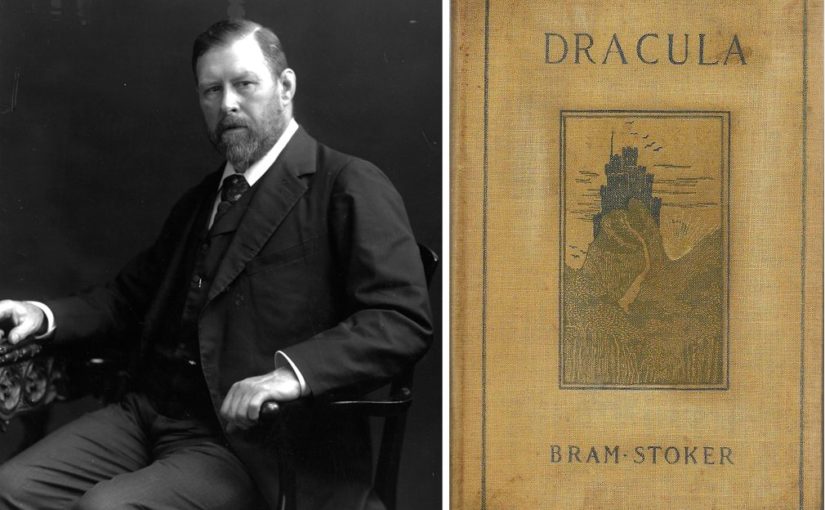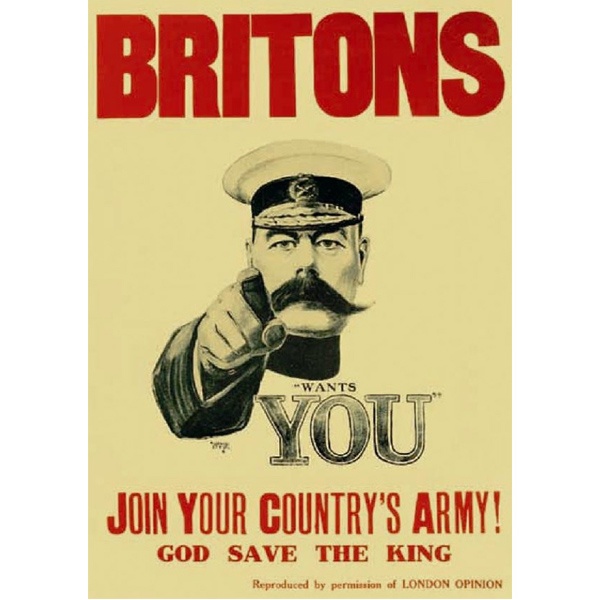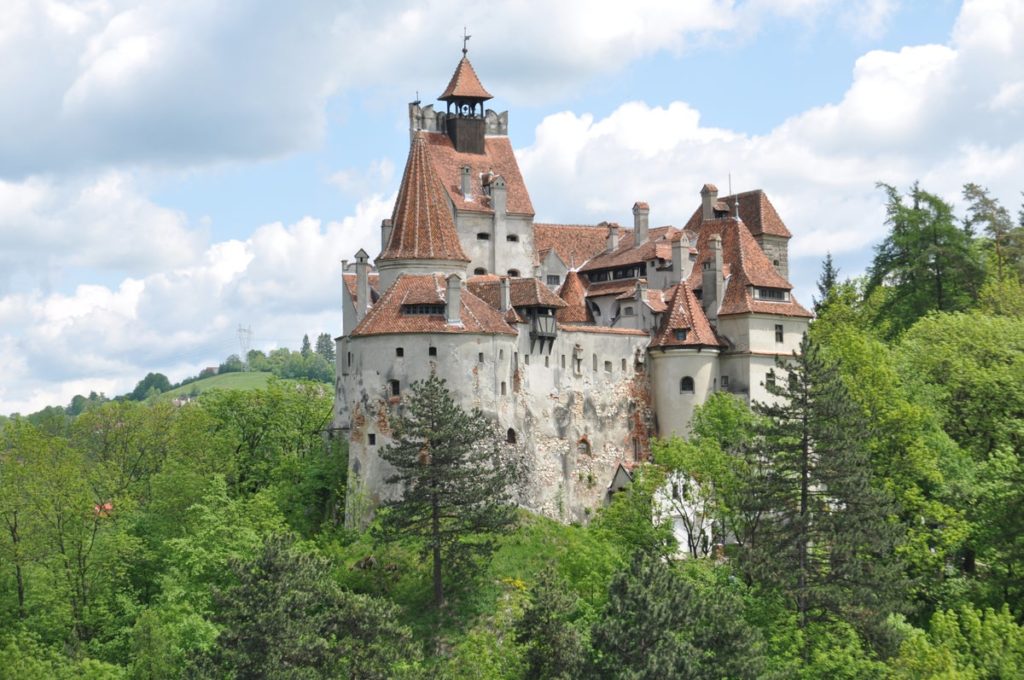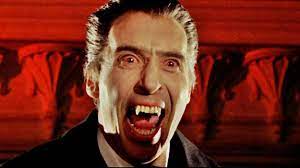The second half of the 19th and early part of the 20th century was a period characterized by the coming into this world of many brilliant individuals who shone in the liberal arts. Bram Stoker was a writer and a Freemason who earned his stand by leaving us the immortal legacy of the successful gothic novel Count Dracula.
Stoker was born in Dublin in 1847 and attended Trinity College, where he received a bachelor’s degree in science in 1870 and a Master in mathematics later. He confessed that until he was seven years of age he could not properly stand up and yet he recovered and turned into a strong, hearty, athletic man, with an immense appetite for work and a remarkable appearance.
Stoker begun his career in the Irish civil service , working as a clerk in the Registrar Office of Petty Sessions in Dublin Castle. But his passionate interest in the dramatic art lead him to do unpaid work as a theatre critic for the Dublin Evening Mail.
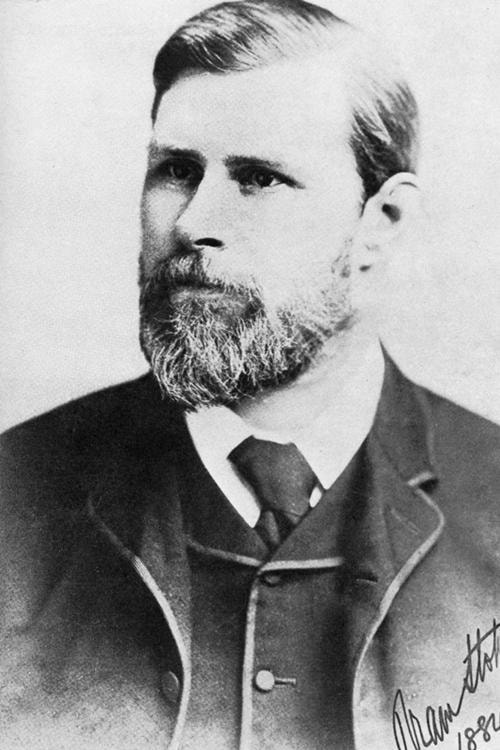
In Dec 1876, following a performance of the Hamlet that he attended and brilliantly reviewed, Stoker was invited to meet the lead actor. The event marked the beginning of a 28 years association of Stoker with the most dominant, in every sense of the word, personality of his life, the legendary English actor John Henry Broadribb , better known with the stage name of Henry Irving.
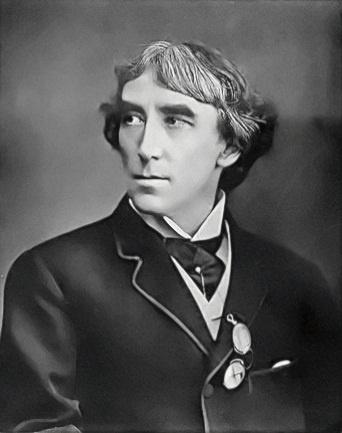
When in 1879 Irving invited Stoker to manage both his performing career and the running of the Lyceum Theatre in Covent Garden, London, Stoker dropped everything in Dublin and run to assist – literally and in everything – the man he worshipped and who in turn exploited the situation to his advantage.
One obituary reads:
I have never known a man’s absorption in another man’s life as much as Stoker was absorbed in Irving’s life. There was something almost umbilical about their relationship.
STOKER THE FREEMASON
Both Stoker and Irving were Freemasons, albeit initiated in different lodges.
The Grand Lodge of England’s records identify Stoker as being a member of Buckingham and Chandos No1150, a Lodge founded in February 1867 and enlisting officers and sergeants of the 1st Middlesex Artillery Volunteers.
Stoker was initiated in February 1883, passed in April and elevated on June 20th of that year. He was only a mason for six years and does not appear to have held any office in the Lodge.
Aside from John Irving, other notable figures who had a presence in Bram Stoker’s life were Oscar Wilde, Sir Conan Doyle, and William Gilbert — of the famed musical partnership Gilbert & Sullivan – all of whom were also Freemasons.
MARRIAGE
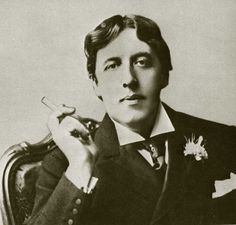
Oscar Wilde 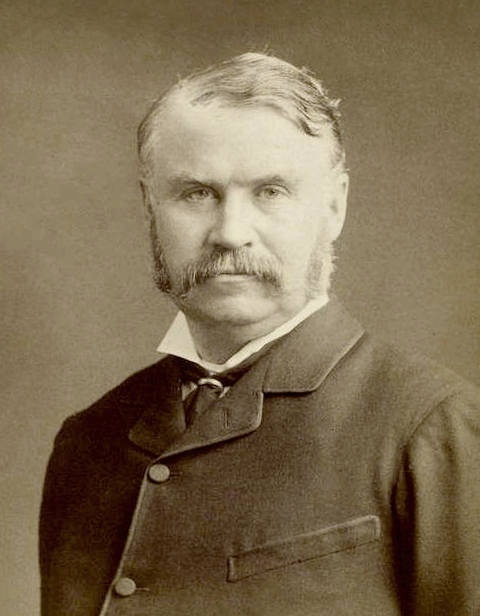
William Gilbert
Bram Stoker and Florence Balcombe[1] grew up in and around Dublin and wed at St. Anne’s Church in December 1878. Florence moved to Ireland from Cornwall when she was only two years of age and she grew to be regarded, in her time, the most beautiful woman in town. Of the famous people in Stoker’s like , Oscar Wilde is known to have had a little affair with young Florence.. Oscar was an undergraduate at Oxford University when he was introduced to her and despite the fact that the two only met a few times, the Irish poet and dramatist – whose reputation rests on his only novel The Picture of Dorian Gray – was said to be heartbroken when he learned that Florence had married. Later he asked Florence to return him the small gold cross he had gifted her, promising to keep it as a remembrance of “ the two wonderful years – the sweetest of all the years of my youth” that he spent courting her. When Oscar changed his sexual orientation his ardour for Florence came to an end and was followed by a long-lasting friendship with the Stoker family[2].
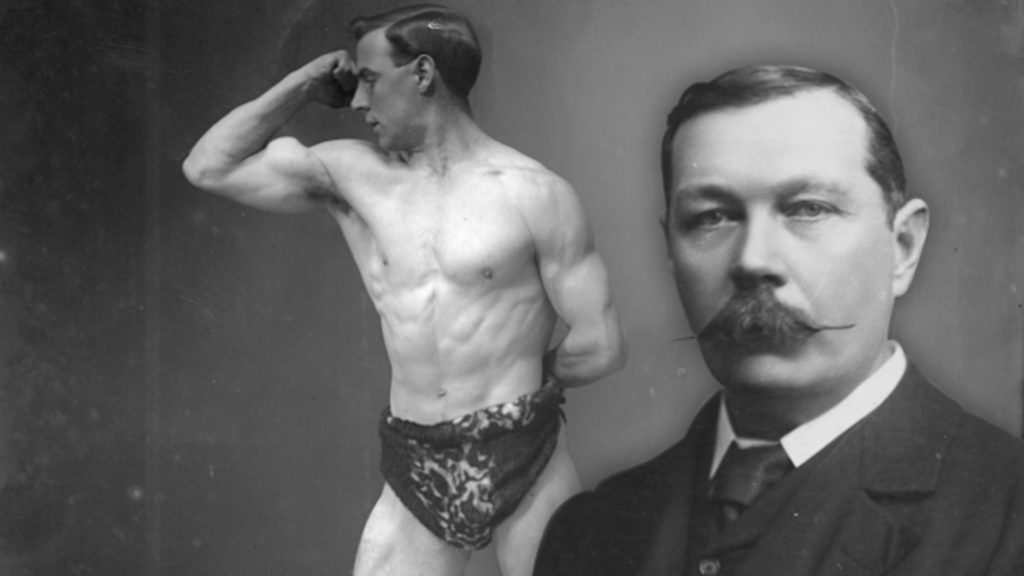
Within a few days of their marriage Bram whisked Florence away to London, where he had been given a managerial position working with and for Henry Irving.

William Parker Stoker , a family descendant , worked as a writer and editor for the Bram Stoker Estate and wrote that Florence carried resentment towards Irving. He was estranged from his wife and Florence felt bitter that he kept dragging her husband away from his marital duties and the family life she would have wished, in favour of lengthy hours spent together at the Lyceum theatre. Stoker and Irving even travelled to America for work and spent several months at the time together, whilst Florence was left living miserably in London. We know , however, that Bram persuaded his older sister Matilda to live with them in Southampton Row and later in Cheyne Walk, London, to ease Florence’s annoyance.
THE VICTORIANS
As the many public scandals of the 19th century show, the Victorians enjoyed sexual activities just as much as we do. But they were perhaps more conscious of their possible negative effect.
Many puritans were shocked by the reported homosexual activity that emerged during Oscar Wilde’s trial, the most disturbing evidence of which were the stained sheets at the Savoy Hotel.
You might also be startled to find out that some of the characters who have been practically revered in British history and portrayed as magnificent examples of masculinity in fact shared a sinfully deviant sexual inclination.
Lord Alfred Douglas (1870-1945) , with whom Oscar Wilde had a liaison, pointed out: “I did with him – and allowed him to do – what was done among boys at Winchester (Douglas’ school) and Oxford…”. It also appears that both men had a predilection for seeking out young male prostitutes, who were so ample available in Victorian London.
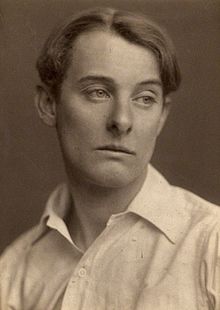
In 1889 there had been a police swoop on a homosexual brothel at N.19 Cleveland Street, north of Soho. Various grandees were implicated including the Earl of Euston, son of the Duke of Grafton, and Lord Arthur Somerset, a servant to the Duke of Clarence (the Prince of Wales’s eldest son). They were only a few names from a lengthy list of aristocrats and wealthy homosexuals recorded in the journals of British history.
Cecil Rhodes preferred to surround himself with male servants and his affair with Neville Pickering, the first secretary of the De Beers Diamond Corporation, presents us with the closest of the homosexual liaison case of the time. The two men lived together and according to Frank Harris[3], Rhodes once said that he passed his time with his close friend Neville “as a boy among boys”.
Frank Harris was an Irish-American journalist and publisher, who was friendly with many well-known figures of his day. He liked to gossip and wrote about Cecil Rhodes’ erotic tendencies describing them as “worthy of Oscar Wilde”.
There are also rumours that both the freemason founder of the boy-scouts movement ,Baden-Powell, and Lord Kitchener sometime liked to take a walk on the wild side and that Lord Curzon told a lady, who had confessed to him she was looking for a young man to marry , that “he had no fondness for women” having been “initiated” into a different practice by Lord Kitchener.
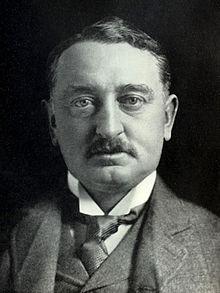
Cecil Rhodes 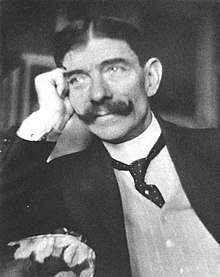
Frank Harris 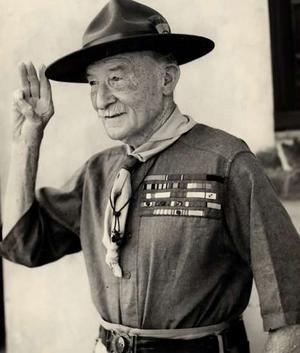
Robert Baden-Powell
There are many books on Bram Stoker’s life but David J. Skal is the only biographer who has shone a light on previously undisclosed aspects of the author of Count Dracula. In ‘Something in the Blood: The Untold Story of Bram Stoker, the Man Who Wrote Dracula’ [4] he unearthed a wealth of controversial material.
“Stoker’s wing were dark and leathery and had been incubated for a long time when he eventually sprouted them.”
Sir Thomas Henry Hall Caine, experienced an unprecedented popularity during his life. He was a British novelist, poet and critic with whom it is strongly suspected Stoker conducted a love affair.
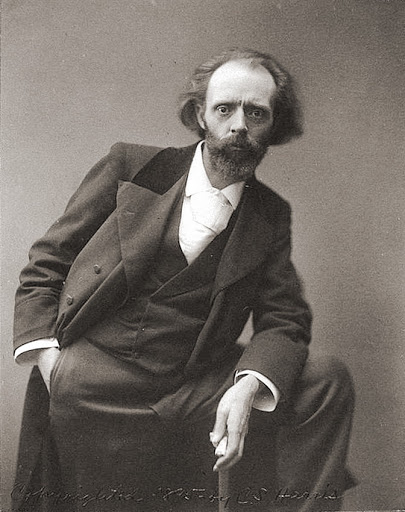
Caine’s devotion to Stoker in one of his letters is almost Grecian[5], homoerotic, in its undisguised description of friendship.
And until Stoker’s death, the two men exchanged letters that were written not merely for the purpose of assisting each other professionally.
Walt Whitman was an American poet, essayist, and journalist whom Stoker met in America and was the only person who never publicly declared his homosexuality. But a passionate Stoker’s letter to him displays a startling proof of a singular sexual preference of the two men. Here is an extract:
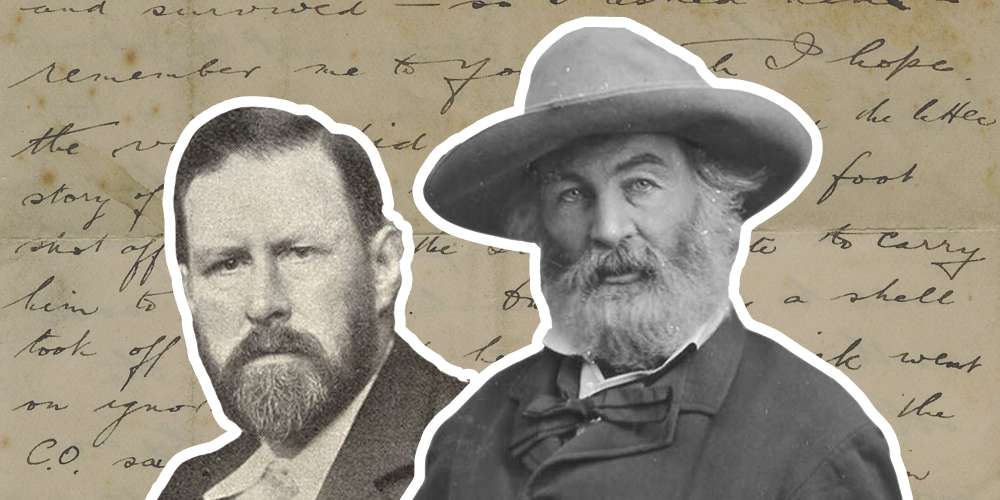
I would like to call YOU Comrade and to talk to you as men who are not poets do not often talk. I think that at first a man would be ashamed, for a man cannot in a moment break the habit of comparative reticence that has become second nature to him; but I know I would not long be ashamed to be natural before you. You are a true man, and I would like to be one myself, and so I would be towards you as a brother and as a pupil to his master. In this age no man becomes worthy of the name without effort. You have shaken off the shackles and your wings are free. I have the shackles on my shoulders still-but I have not wings.[6]
ILLNESS AND DEATH
Stoker lived in Chelsea for more than thirty years until moving to No. 26 St George’s Square, Pimlico, where he died quietly on April 20th, 1912.
In his life he suffered with gout and in 1905, when he was 58, he had his first stroke.
The cause of death on Stoker’s certificate presented by Bram’s only son Noel Stoker to the Registrar reads :
- Locomotor Ataxy- 6 months
- Granular Contracted Kidney.
- Exhaustion
- Certified by James Browne M.D.
This cause of death may seem a pretty plausible and legitimate one but “the devil is in the details” and here the devil is in the first two words of the certification : Locomotor Ataxy.
Ataxia is a progressive illness that can develop at any age and it is usually caused by damage to a part of the brain known as the cerebellum, but it can also be caused by damage to the spinal cord or other nerves. For Dr Dick Collins [7] the latter is a more credible diagnosis. In his 2008 article “The Devil and Daniel Farson: How did Bram Stoker die? he explains that a spine ailment like a lesion or a curvature, which some suspect is what Stoker might have experienced in his childhood, would have been treated with stretching, exercises, and plaster in those days; but Stoker never mentioned any of those remedies. On the other hand,if the lesion in the spine was purely internal, only the nerves rather than the vertebrae would have been affected, resulting in a more fitting diagnosis of spina bifida occulta.
Ataxia can get worse with time. But patients suffering from a form of syphilis can also present Ataxia together with neurological manifestations such as headaches, seizures, hearing loss. In the 19th century Locomotor Ataxia, was merely a euphemism for the shame of mortality from the sexually transmitted disease “syphilis”, the same sexually transmitted illness that is said to have killed Oscar Wilde. Syphilis was not treatable and the latter phases of the disease were defined by severe mental and physical degeneration.
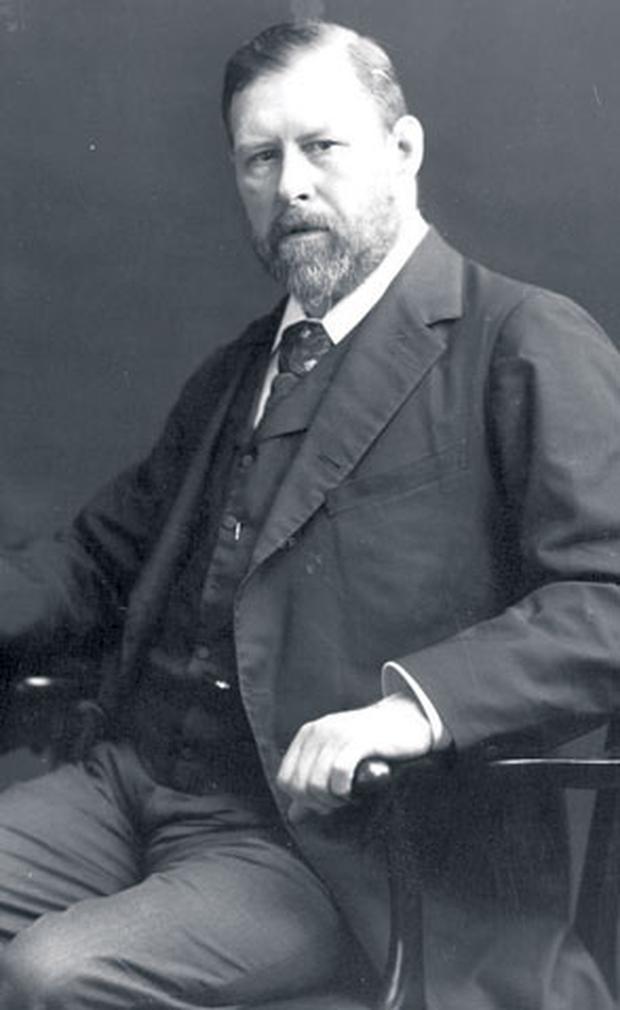
If Stoker ever contracted syphilis, Bram’s brother grandson Daniel Farson [8] reveals how that might have occurred :
He probably caught syphilis around the turn of the century, possibly as early as the year of Dracula, 1897. (It usually takes ten to fifteen years before it kills.) By 1897 it seems that he had been celibate for more than twenty years, as far as Florence was concerned. This would explain Bram’s reputation – as a “womaniser”. Possibly the disease was contracted in Paris, where so many “faithful” husbands, such as Charles Dickens and Wilkie Collins, had gone for discreet pleasure before him. It is known that Bram did go to France on several occasions, and said the only words he needed there were “pain,” “vin” and “bain.” There is even the intriguing report that he brought money for Oscar Wilde, though this is not referred to in any of the Wilde letters.
If Stoker’s public life as Irving’s right-hand man concealed something more perverse and dissolute, it would explain the conundrum at the heart of Stoker’s marriage to Florence Balcombe, a society beauty who was courted by a number of scholarly men in the 1880s and 1890s. Why did she keep Stoker a “celibate” – as Bram openly admitted – for over twenty years and why did Florence decide to have her ashes scattered rather than interred with her husband?
I have seen similar situations in history where a spouse, on learning that her husband had contracted a venereal disease , put an end to her sexual contacts with him and even went on to take – with her husband’s acquiescence – a younger and healthier partner as a lover. Take for example Wolfgang Amedeus Mozart – whom some biographers think contracted a sexual disease and even died of it – and his wife Constanze. She had a liaison with Franz Xaver Süssmayr , Mozart’s pupil and faithfully aider, while taking the cure at the Spas and even conceived an illicit child.
With regards to the character of Bram Stoker, Daniel Farson wrote :
The more I learn about him [Stoker] the more schizophrenic he appears. Prepared to use his fists, he “knocked down two ruffians and dragged them to the nearest police station,” when they tried to rob him as he returned to his hotel after a lecture to Edinburgh University; ready to risk his life, he jumped into the Thames from a passing boat when he saw a man drowning; but he was no less afraid to champion Walt Whitman when Walt’s Selected Poems were attacked by William Michael Rossetti in 1868 as morally offensive.
Farson also reports that his own later mother had told him a story that gave way to suggestions that Stoker might have been a schizophrenic. On the days of Queen Victoria’s Diamond Jubilee celebrations in London she remembered “how his [Bram’s] behaviour startled the crowd as he stood outside (his home) handing out oranges from a large paper bag.”
While much has been said about the Masonic motifs in Count Dracula, precise quotes are hard to come across, with the exception of that in chapter 2 when the Count says to Jonathan Harker: “Welcome to my house! Enter freely and of your own will!“, This is a familiar expression to freemasons, but it is by no means exclusively Masonic. A more specific Masonic phrase is instead found in The Lair of the White WormIn when it goes : “We two are, I take it, tiled. So that there come no wrong or harm to anyone else in the enlargement of the bounds of our confidence!“
Stoker died on 20 April 1912 at St.George’s Square and his body was cremated at Golders Green Cemetery, London.
CONCLUSIONS
Stoker did not appear to progress in Freemasonry, and resigned after six years of little or no involvement. What is the reason for this?
Well, it’s probable that he used the Craft to network and conduct business.
Irving’s success – which eventually earned him a knighthood – allowed him to enter powerful circles, and the need for networking diminished. Irving was not only close to Princes and Prime Ministers, but also friends with Edward, Prince of Wales, who was Grand Master at the time.
As a result, Stoker abandoned Freemasonry, which clashed with his hectic schedule and long hours at the Theatre, as well as his frequent travels.
Stoker’s estate was valued at £5,269/12s/7d, which in today’s money is roughly equivalent to £420,000. If Stoker had lived today, the Dracula brand and its associated rights would very definitely have brought him by far more money and prosperity.
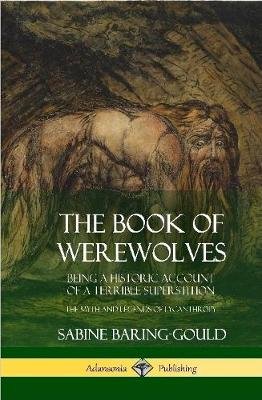
The idea for the novel came to Stoker after he had borrowed the following publications ,in 1890, from the London Library near Piccadilly Circus:
- The Book of Werevolves (by Sabine Baring Gould)
- Round about the Carpathians (by Andrew Crosse)
- Account of the Principalities of Wallachia and Moldavia (by William Wilkinson).
All of these books helped him come up with the premise for his fiction, which he started writing while on business in Philadelphia, America. In his notes Stoker wrote:
- Lawyer’s letters
- Wolves
- Arrival at the castle
- Loneliness and a kiss (and in quotes: “this man belongs to me!”)
The latter was clearly inspired by a particular sexual fantasy and indeed the character of Dracula is partly about dominance and dependence, like in a sexual relationship.
But regardless of what the true sexuality of Stoker was and whether he was a committed – or less – Freemason, he certainly gave the world a one-of-a-kind work of suspense and terror.
He developed the myth of Dracula and Van Helsing and portrayed the universal law of duality present in Good and Evil, Darkness and Light, Death and Immortality, also found in Masonic teachings.
In closing, I want to denounce what I consider ethically wrong, i.e. that facts should should be withheld or changed by biographers in order to protect reputations. It is also unethical to allow historians to wipe the slate clean of any controversial truths in order for some Nations to foster a sense of alleged superiority among their people.
But aside from these considerations, I am confident that millions of readers share my total admiration for such a Brother’ s creative brilliance.
by De La Riviere
NOTES
[1] the daughter of Lt. Col. James Balcombe and Phillippa Anne Marshall
[2] Bram Stoker had been a classmate of Oscar’s brother Willie Wilde
[3] Frank Harris (14 February 1855 – 26 August 1931) was an Irish-American editor, novelist, short story writer, journalist and publisher
[4] [9781631522741, 672 pp. Hardcover: October 2016 Paperback: October 2017]
[5] Grecian is a term originally used by classicists to describe the primarily homoerotic customs, practices, and attitudes of the ancient Greeks. It was frequently used as a euphemism for homosexuality and pederasty.
[6] From “ Something in the Blood: The Untold Story of Bram Stoker, the Man Who Wrote Dracula Hardcover – by David J. Skal, 2016
[7] A graduate of Cambridge (Trinity), Dr. Richard Collins has produced editions of two books (The String of Pearls and Wagner and the Were-wolf) with a third (The Necromancer) forthcoming. He is retired and lives in County Cork, Ireland.
[8] Daniel Farson’s biography, Bram Stoker: The Man Who Wrote Dracula, first appeared in 1975. Much of it consists of quotation from Stoker’s Personal Reminiscences of Henry Irving (1906), together with lengthy expositions of his novels and short stories. Farson was the grandson of Bram’s brother, Thomas.
SOURCES
https://arena.londonmasons.org
Freemasonry.bcy.ca/biography/stoker_b/stoker_b.html
Bramstokerestate.com/florence-anne-lemon-balcombe
Wilde’s Women by Eleanor Fitzsimons , published by Duckworth Overlook in October 2015.
Tom Cardamone October 31, 2017
Moneysorter.co.uk
Pglm.org.uk/theatreland-article
A masonic connection to the Dracula story and to Theatreland in Covent Garden by W Bro Stan Marut, News Editor for the Media Team
Stoker and Terry by W. Bro Stan Marut
100 years ago today: the death of Bram Stoker By Roger Luckhurst , April 20th 2012 – (https://blog.oup.com/2012/04/bram-stoker-death-centenary-dracula/ )
Wilkipedia.org
- CAGLIOSTRO’S EGYPTIAN RITE - November 22, 2022
- THE FREEMASON WHO WROTEDRACULA – BRAM STOKER - June 29, 2021

